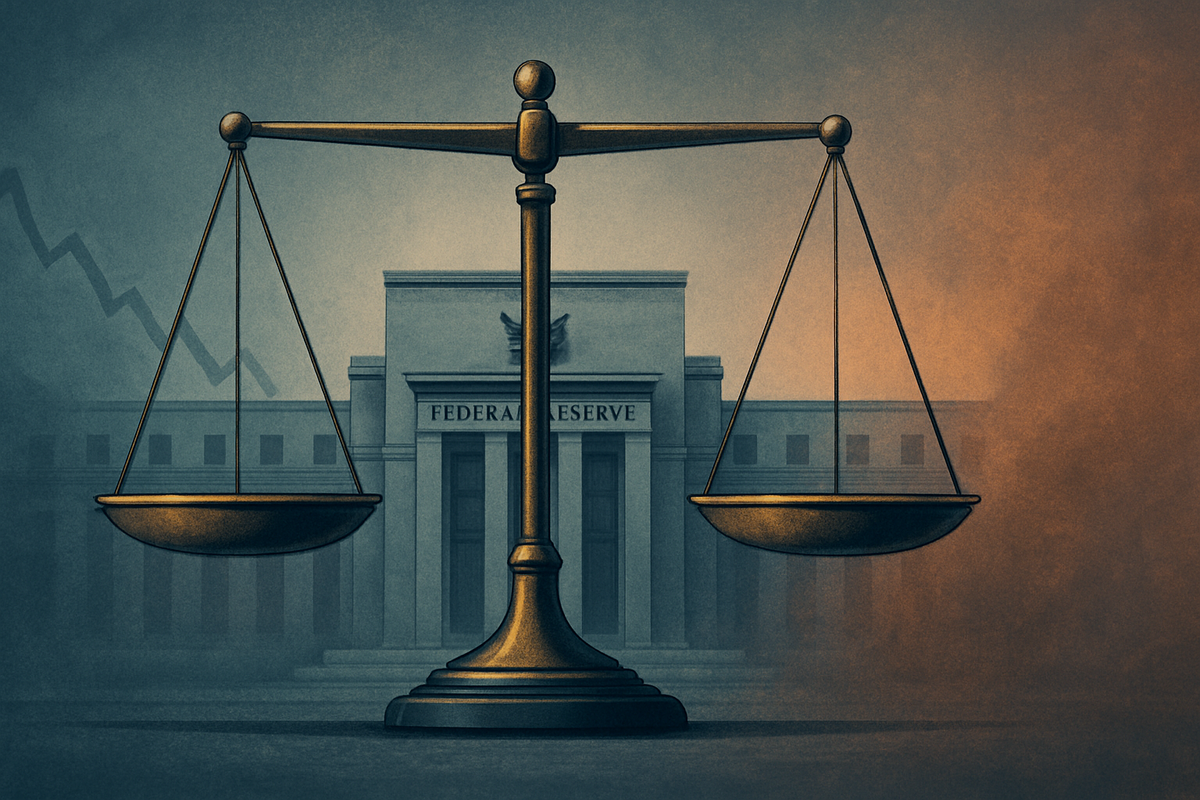
In a significant move that underscores growing concerns about the U.S. economy, the Federal Reserve delivered its second interest rate cut of 2025 on Wednesday, October 29, 2025. This decision, which lowered the benchmark federal funds rate by 25 basis points to a new target range of 3.75% to 4.00%, signals the central bank's intensified effort to bolster a weakening labor market and stimulate economic activity amidst persistent, elevated inflation. The market's initial reaction was a mix of apprehension and disappointment, as investors grappled with the implications of the Fed's cautious forward guidance and the complex economic backdrop.
The rate cut, a departure from the aggressive tightening cycle of previous years, highlights the delicate balancing act faced by the Federal Open Market Committee (FOMC). While aiming to prevent a deeper economic slowdown, the Fed must also contend with inflation that continues to hover above its 2% target, raising the specter of a challenging "stagflation-lite" environment. This pivotal moment has immediate implications for borrowing costs, corporate profitability, and the broader trajectory of the U.S. and global economies.
A Deeper Dive into the Fed's October Maneuver
The Federal Reserve's decision to cut rates for the second time this year was a direct response to a confluence of concerning economic indicators. The 25-basis-point reduction on October 29, 2025, brought the federal funds rate below 4% for the first time since 2022. This followed a similar 25-basis-point cut on September 17, 2025, which had set the rate to 4.00%-4.25%.
The timeline leading up to this second cut was marked by increasing economic distress. The August 2025 jobs report, released on September 5, painted a bleak picture of the labor market, showing only 22,000 nonfarm payroll additions and an unemployment rate edging up to 4.3 percent. Long-term unemployment also saw a significant increase. Compounding this, the U.S. economy faced a federal government shutdown commencing October 1, 2025, which created a "data blackout," depriving the Fed of crucial economic statistics, including the September jobs report and potentially October's inflation data. Despite this, the delayed September 2025 Consumer Price Index (CPI) report, released on October 24, revealed that inflation remained elevated at 3.0 percent year-over-year, well above the Fed's 2% target.
Key players in this decision included the Federal Open Market Committee (FOMC), led by Chairman Jerome Powell. Powell acknowledged "elevated uncertainty about the economic outlook" and noted "strongly differing views" among committee members regarding future actions. He famously described the Fed's approach as "driving in the fog," indicating the challenges posed by incomplete data. Notably, Governor Stephen Miran consistently dissented, advocating for a more aggressive 0.50 percentage point cut, aligning with public pressure from the U.S. President for lower rates. Conversely, Kansas City Fed President Jeffry Schmid dissented, preferring no change to the federal funds rate at all, highlighting the deep divisions within the committee.
The immediate market reaction to the October cut was largely mixed to negative. Major stock indices, including the Dow Jones Industrial Average and S&P 500, pared back earlier gains or slipped after Chairman Powell's cautious remarks that a further rate cut in December was "not a foregone conclusion." This tempered investor expectations for continued aggressive easing. Treasury yields rose, and global markets showed a varied response, indicating a sense of unease about the Fed's assessment of the economy and its future policy path.
Who Wins and Who Loses? Navigating the Rate Cut Landscape
The Federal Reserve's rate cut, while intended to stimulate growth, creates a distinct landscape of winners and losers among public companies and sectors, particularly within the context of a slowing labor market and persistent inflation.
Potential Winners:
- Real Estate and Homebuilders: Lower mortgage rates make homeownership more affordable, boosting demand. Companies like D.R. Horton (NYSE: DHI) and Lennar Corp. (NYSE: LEN) are poised to benefit from increased housing activity. Real Estate Investment Trusts (REITs) also see reduced borrowing costs for their property portfolios.
- Consumer Discretionary: With reduced household debt expenses, consumers may have more disposable income for non-essential goods and services. Retailers such as Target (NYSE: TGT) and Walmart (NYSE: WMT), as well as auto manufacturers and travel companies, could see increased spending.
- Information Technology (Tech) and Capital-Intensive Industries: Tech companies, which often rely on significant capital for research and development, benefit from cheaper financing. Lower discount rates also enhance the valuation of growth stocks. Mid-cap tech stocks and those with higher debt loads stand to gain. Major tech players like Microsoft (NASDAQ: MSFT), Meta Platforms (NASDAQ: META), and Alphabet (NASDAQ: GOOGL), heavily investing in AI infrastructure, also benefit from a lower cost of capital.
- Utilities: These capital-intensive companies with substantial debt burdens see direct reductions in financing costs. As bond yields fall, the stable dividends offered by utilities become more attractive to income-seeking investors. Duke Energy (NYSE: DUK) and Southern Company (NYSE: SO) are examples of companies that could see improved margins and stock performance.
- Small-Cap Companies: Often more sensitive to interest rate changes due to higher debt and growth potential, small-cap stocks can find it easier to secure financing for expansion.
- Infrastructure and Renewable Energy: Large-scale projects in these sectors become more financially viable with lower borrowing costs, encouraging investment in roads, public transit, solar farms, and energy storage.
Potential Losers:
- Financials (Banks, Insurers, Money-Market Managers): Commercial banks and diversified financials often experience net interest margin (NIM) compression as short-term rates fall faster than long-term rates, squeezing profitability. Life and P&C insurers, who reinvest premiums in bonds, will lock in lower yields, diminishing their return on equity.
- Seniors and Savers: Individuals relying on fixed-income investments like savings accounts, CDs, and money market funds will see diminished returns, impacting their income, particularly problematic with persistent inflation eroding purchasing power.
- Companies with Large Cash Positions: While generally strong, companies holding significant cash reserves may see a slight reduction in the interest income generated from those reserves.
The nuanced environment of slowing growth and persistent inflation means that while lower borrowing costs provide some relief, eroding purchasing power and tempered consumer confidence could offset some benefits, keeping overall market volatility elevated.
Wider Significance: A Global and Political Quagmire
The Federal Reserve's second rate cut in 2025 is not an isolated event but rather a critical response to deeply intertwined global and domestic economic challenges. It signals a broader shift in monetary policy amid a global economic slowdown, escalating trade tensions, and significant domestic political interference.
Globally, 2025 is projected to see the weakest growth since 2008, outside of outright global recessions, with global growth expected to slow to 2.3%. This deceleration is broad-based, affecting major economies including the U.S., Canada, Mexico, and China. Ongoing trade tensions, particularly "Trump's tariffs," have contributed significantly to this uncertainty, raising production costs, disrupting supply chains, and amplifying financial turbulence. These tariffs have contributed to persistent inflation, with the CPI remaining at 3.0% year-over-year in September, well above the Fed's 2% target. This combination of slowing growth and elevated inflation presents a challenging "stagflation-lite" scenario, reminiscent of the 1970s, albeit less severe.
The ripple effects on international markets are substantial. A Fed rate cut typically leads to a weakening U.S. dollar, making dollar-denominated assets less attractive and potentially redirecting investment capital towards higher-yielding international markets. Emerging markets (EMs) often benefit from a weaker dollar, which eases their dollar-denominated debt burden and makes their exports more competitive. Major trading partners like the Euro Area might see their currencies strengthen, while commodity currencies could outperform. However, EMs must remain vigilant about capital flow volatility.
Domestically, the regulatory and policy landscape is complicated by the ongoing federal government shutdown, which commenced October 1, 2025. This "data blackout" has forced the Fed to "fly blind," making decisions without crucial economic data on labor, inflation, and growth. This lack of comprehensive information elevates uncertainty and risks. Furthermore, the Fed has been under intense political pressure to cut rates, particularly from the U.S. President. While the Fed is theoretically independent, such pressure can erode confidence in its autonomy and lead to interpretations that decisions are politically motivated rather than purely data-driven. The government shutdown itself is detrimental to the economy, reducing GDP growth and weighing on consumer spending.
Historically, the Fed has cut rates under similar conditions of slowing growth and inflation concerns. The 1970s stagflation era serves as a cautionary tale. More recently, the Gulf War Recession (1990-1992) saw the Fed significantly cut rates in response to rising oil prices, inflation, and a real estate bubble. However, the current environment is unique due to the persistent inflation above target while cutting rates, and the unprecedented "data blackout" from the government shutdown, forcing the Fed to operate with incomplete information.
What Comes Next: Navigating Uncertainty
The Federal Reserve's second rate cut of 2025 has set the stage for a period of continued economic and market uncertainty. The path forward for monetary policy is far from clear, with significant divisions remaining within the FOMC.
Short-Term and Long-Term Possibilities: Fed Chair Jerome Powell's cautious remarks that a further rate cut in December is "not a foregone conclusion" suggest that the Fed's approach will remain strictly "data-dependent." Future actions will hinge on the evolution of labor market dynamics, inflation trends, economic growth, and financial market conditions. While some economists anticipate additional cuts, potentially bringing the federal funds rate to 2.25%-2.50% by the end of 2027 if the labor market weakens further, a pause in rate cuts is also a strong possibility if inflation proves more stubborn or if economic growth surprises on the upside. The ongoing government shutdown, by obscuring critical data, complicates these decisions, potentially leading to increased short-term interest rate volatility.
Strategic Pivots and Adaptations: For businesses, this environment presents opportunities for strategic refinancing of existing high-interest debt and securing favorable financing for new investments and expansion. Companies should re-evaluate cash management strategies, potentially investing in R&D, marketing, or M&A to capitalize on cheaper capital. For investors, diversification across asset classes (stocks, bonds, real estate, alternatives) remains crucial. Growth-oriented assets, particularly in technology, may benefit from lower discount rates. In fixed income, investors might consider locking in higher yields on quality corporate or municipal bonds, while being mindful of reinvestment risk in very short-term instruments. A weaker U.S. dollar could boost the appeal of international equities, especially in emerging markets. Assets like gold and Bitcoin (a higher-risk asset) could serve as hedges against inflation uncertainty.
Market Opportunities and Challenges: Market volatility is expected to remain elevated. Opportunities may emerge in sectors that benefit from lower borrowing costs and increased consumer spending, such as real estate, consumer discretionary, and technology. Emerging markets could also see increased capital flows and currency appreciation. However, challenges include the risk of sustained inflation eroding purchasing power and the potential for a deeper economic slowdown. The divided opinions within the Fed and significant macro uncertainties could trigger reassessments of risk premia across all asset classes.
Potential Scenarios and Outcomes: The economic future could unfold in several ways:
- Soft Landing (40% probability): Inflation gradually declines to the 1.5%-2.5% target while real GDP growth remains positive (above 1%), a challenging "Goldilocks" scenario where the Fed successfully tames inflation without causing a significant downturn.
- Recession (27% probability): A significant decline in economic activity, potentially triggered by the weakening labor market and slowing growth that prompted these rate cuts. A "hard landing" implies overaggressive monetary policy curbing inflation at the cost of a U.S. recession.
- Stagflation (28% probability): A challenging scenario marked by elevated inflation (over 3%) alongside subdued or negative output growth (less than 1%) and a languishing labor market. The combination of persistent inflation and slowing growth, exacerbated by tariffs, increases the risk of this outcome.
Comprehensive Wrap-Up: A Precarious Path Ahead
The Federal Reserve's second interest rate cut of 2025 is a critical inflection point, signaling the central bank's urgent response to a deteriorating labor market and heightened economic uncertainty, even as it grapples with stubbornly persistent inflation. The 25-basis-point reduction to a target range of 3.75%-4.00% reflects a complex balancing act, prioritizing employment stability while navigating an inflationary environment.
Moving forward, the market can anticipate continued volatility as investors meticulously analyze every piece of economic data and every word from Federal Reserve officials. The divisions within the FOMC, as highlighted by Chairman Powell, suggest that the path of future rate adjustments is far from predetermined. The "data-dependent" mantra will be tested by the ongoing government shutdown, which has created a challenging information vacuum for policymakers.
The lasting impact of these rate cuts will depend on the Fed's ability to delicately manage its dual mandate of maximum employment and price stability. The risk of a "stagflation-lite" scenario, where slowing growth coexists with elevated inflation, remains a significant concern, distinguishing this period from previous easing cycles. The political pressure on the Fed and the disruption caused by the government shutdown also raise questions about the central bank's independence and its capacity to make unbiased, data-driven decisions.
Investors should remain vigilant in the coming months, closely monitoring key indicators such as future FOMC meeting outcomes, inflation reports (particularly core inflation), and detailed jobs data. The resolution of the federal government shutdown will be crucial, as it will restore the flow of vital economic information. Strategic diversification, a focus on companies with strong fundamentals and growth prospects, and an awareness of global economic trends will be paramount for navigating this precarious economic landscape.
This content is intended for informational purposes only and is not financial advice






